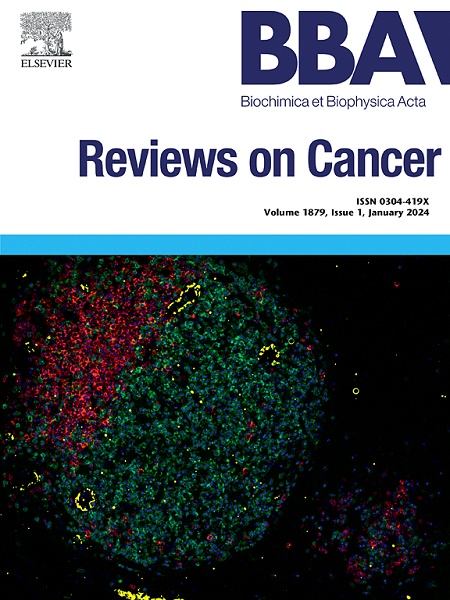SENP3:癌症和疾病。
IF 9.7
1区 医学
Q1 BIOCHEMISTRY & MOLECULAR BIOLOGY
Biochimica et biophysica acta. Reviews on cancer
Pub Date : 2025-02-01
DOI:10.1016/j.bbcan.2025.189260
引用次数: 0
摘要
SUMOylation是一种蛋白质修饰过程,涉及到一个小的泛素样修饰物(SUMO)共价附着在目标蛋白质上的特定赖氨酸残基上。这种修饰可以影响蛋白质的功能、定位、稳定性和相互作用,从而调节各种细胞过程。改变某些蛋白质的sumo化有望成为治疗特定癌症和疾病的潜在方法。其中,SENP3可以通过调节deSUMOylation过程影响靶蛋白,进而影响下游基因的转录活性,起到促进或抑制癌症的作用。SENP3调节多种信号通路中蛋白质的SUMO状态,通过调节特定信号分子的活性来影响细胞反应和肿瘤进展。此外,SENP3通过调节关键细胞周期蛋白来促进细胞生长和分裂。在DNA修复的背景下,SENP3通过去umoylating修复因子来调节DNA修复相关蛋白的活性,从而增强DNA修复,维持基因组的稳定性。此外,SENP3在其他多种疾病中也有特定的功能。SENP3的复杂作用表明其作为治疗靶点和生物标志物的潜力。本文章由计算机程序翻译,如有差异,请以英文原文为准。
SENP3: Cancers and diseases
SUMOylation is a protein modification process that involves the covalent attachment of a small ubiquitin-like modifier (SUMO) to a specific lysine residue on the target protein. This modification can influence the function, localization, stability, and interactions of proteins, thereby regulating various cellular processes. Altering the SUMOylation of certain proteins is expected to be a potential approach for treating specific cancers and diseases. Among these, SENP3 can affect target proteins by regulating the deSUMOylation process, which in turn influences the transcriptional activity of downstream genes, playing a role in either promoting or inhibiting cancer. SENP3 regulates the SUMO status of proteins in numerous signaling pathways, modulating the activity of specific signaling molecules to impact cellular responses and tumor progression. Additionally, SENP3 promotes cell growth and division by deSUMOylating key cyclins. In the context of DNA repair, SENP3 regulates the activity of proteins associated with DNA repair by deSUMOylating repair factors, thereby enhancing DNA repair and maintaining genome stability. Furthermore, SENP3 has specific functions in various other diseases. The complex roles of SENP3 indicate its potential as both a therapeutic target and a biomarker.
求助全文
通过发布文献求助,成功后即可免费获取论文全文。
去求助
来源期刊

Biochimica et biophysica acta. Reviews on cancer
医学-生化与分子生物学
CiteScore
17.20
自引率
0.00%
发文量
138
审稿时长
33 days
期刊介绍:
Biochimica et Biophysica Acta (BBA) - Reviews on Cancer encompasses the entirety of cancer biology and biochemistry, emphasizing oncogenes and tumor suppressor genes, growth-related cell cycle control signaling, carcinogenesis mechanisms, cell transformation, immunologic control mechanisms, genetics of human (mammalian) cancer, control of cell proliferation, genetic and molecular control of organismic development, rational anti-tumor drug design. It publishes mini-reviews and full reviews.
 求助内容:
求助内容: 应助结果提醒方式:
应助结果提醒方式:


